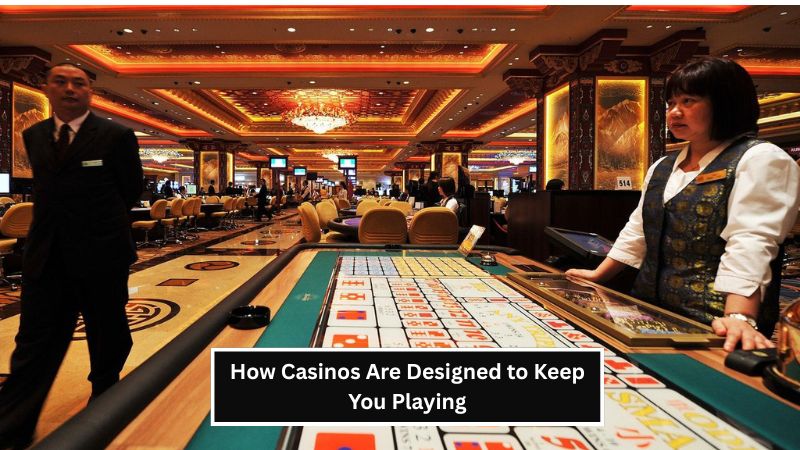Casinos are not just places for gambling; they are meticulously designed environments created to keep players engaged, entertained, and, most importantly, spending money. Behind the flashy lights, the constant sounds of coins and jackpot bells, and the allure of big wins, casinos employ various psychological and architectural strategies to ensure visitors stay inside and keep playing. These strategies are not random; they are the result of years of research into human behavior and how it affects gambling. In this blog post, we will explore the most effective design elements and tactics that casinos use to keep players in the game.
The Layout and Flow of a Casino
One of the first things you’ll notice when entering a casino is how the space is organized. Unlike typical buildings, casinos are intentionally designed to be disorienting. This layout is not by accident; it is part of a sophisticated strategy to keep you inside for as long as possible.
Open and Inviting Spaces
Casinos often feature expansive open spaces that seem welcoming and endless. By avoiding windows and clocks, the design prevents visitors from knowing how much time has passed. Without clear markers of time, players can easily lose track of how long they’ve been playing. This “time distortion” tactic encourages gamblers to stay longer and gamble more.
Strategic Placement of Games
Slot machines are often placed in clusters to create a feeling of abundance and excitement. By grouping slots together, casinos create a sense of competition and encourage people to jump in and try their luck. In addition, the design often leads players through rows of machines or tables, making them more likely to stop and play. Table games like blackjack and roulette are strategically placed in areas where they are easy to spot, creating an inviting atmosphere. The central location of these games increases their appeal, drawing players who might otherwise pass by unnoticed.
Limited Access Points
Most casinos have limited entry and exit points. This controlled access to the building ensures that once visitors are inside, they are less likely to leave without making a few bets. Some casinos use this layout to funnel people toward high-stakes games or special offers, ensuring that every player is guided into the gambling experience.
Lighting, Sound, and Ambiance
Lighting and sound are essential components of casino design. These elements are carefully crafted to set the mood, influence player behavior, and create an environment where players feel comfortable and engaged.
Bright Lights and Flashing Signs
The lights inside a casino are typically bright and constantly changing. The most attention-grabbing lights often come from slot machines or games with jackpots. These lights are not random; they are designed to capture attention and create excitement. Flashing lights and bright colors generate positive emotions in players, which makes them feel as though they are on the verge of a big win, encouraging them to keep playing. Even the absence of natural light can have an effect, making players more susceptible to playing longer and losing track of time.
The Soundscape
Sound is another carefully orchestrated aspect of casino design. The constant chime of slot machines paying out, the ringing of a jackpot, the shuffle of cards, and the murmurs of other players all combine to create a thrilling atmosphere. Studies have shown that the sound of a winning machine or the buzz of activity increases dopamine production, making players feel good and encouraging them to continue gambling. Even the sound of footsteps or coins in machines can influence players’ behavior, making them think that others are winning and increasing their desire to join in.
Comfortable Temperature and Environment
Casinos are also designed to be comfortable. The temperature is carefully controlled to prevent players from feeling too cold or too hot, as discomfort could lead to players leaving early. Comfortable seating, soft furnishings, and even the scent of the air are all part of the strategy. The goal is to make the environment so enjoyable that players forget about everything else and focus entirely on the games.
The Psychology of Reinforcement
One of the most significant factors in keeping players engaged is the use of psychological principles, especially the concept of reinforcement. In gambling, reinforcement refers to how a player’s behavior is shaped by rewards or punishments. Casinos use this principle to encourage players to continue gambling.
Random Rewards and Near Wins
Slot machines are the perfect example of reinforcement psychology in action. Although the outcome of each spin is random, many machines are designed to give players “near wins.” These near wins occur when the symbols on the machine almost align, giving players the illusion that they were close to winning. This experience creates a sense of anticipation, which triggers a dopamine response in the brain, encouraging players to try again.
In addition, random rewards in the form of bonus rounds or jackpots are strategically designed to give players just enough to keep them engaged. By offering frequent, small wins, casinos can maintain a player’s interest without draining their bankroll. This creates a cycle of behavior where players believe that a big win is just around the corner, even though statistically, they may be losing in the long run.
The Losses Disguised as Wins
Another tactic casinos use is the “losses disguised as wins” strategy. Players may receive a small payout that is less than their initial bet, but because it’s framed as a “win,” they may feel like they’ve succeeded. For example, if a player wagers $5 and receives a payout of $4, they are still technically at a loss, but the machine may flash lights and play celebratory sounds to make them feel as though they won something significant. This technique taps into the human tendency to focus on wins and ignore losses, keeping players hopeful and engaged.
The Power of Consistency and Familiarity
Casinos also use familiar patterns to help players feel at ease. The consistency of game rules and the predictability of outcomes create a sense of control, even though players may not fully understand how the games work. For example, players may gravitate toward games like roulette or blackjack because they are widely known and easy to understand. This familiarity makes it more likely that they will continue to play, as they are less intimidated by complex games.
The Use of Rewards Programs and Incentives
Casinos know that offering incentives can keep players coming back. Many casinos employ loyalty programs that reward players with points for every dollar wagered. These points can be redeemed for various rewards, including free meals, hotel rooms, and even cash. The idea is that as players accumulate rewards, they feel a sense of accomplishment and are more likely to return to the casino in the future.
VIP Programs and High-Roller Perks
For frequent or high-stakes players, casinos offer exclusive VIP programs. These programs are designed to make high rollers feel special and valued. VIPs receive personalized service, including dedicated hosts, private gaming areas, luxury accommodations, and access to exclusive events. These high-end perks make players more likely to return, as they associate the casino with luxury and exclusivity.
Social Interaction and Gamification
Casinos also capitalize on the social aspect of gambling. Many games, especially table games like blackjack, poker, and roulette, involve social interaction with other players and dealers. This sense of community and the excitement of competing against others can encourage players to continue gambling, as they feel part of a social experience.
Gamification and Interactive Features
With the rise of online casinos, gamification has become a significant part of the experience. Gamification involves integrating elements of video games, such as achievements, leaderboards, and challenges, into gambling platforms. This strategy taps into players’ competitive nature and makes gambling feel like a more interactive and rewarding experience. The integration of gamified features into both online and physical casinos helps to create a more engaging environment, ensuring players are more likely to continue playing.
Conclusion
Casinos are designed with one main goal in mind: to keep you playing. From their disorienting layouts to the use of psychological tactics and reward programs, every element is meticulously crafted to encourage gamblers to stay longer, spend more, and return for future visits. Understanding these design elements can help players recognize when they are being influenced by their surroundings. While casinos can offer exciting experiences and the potential for large winnings, it’s important for players to remain mindful of how the environment is engineered to keep them engaged.
By being aware of these strategies, players can make more informed decisions about how much time and money they spend at the casino. After all, the house always wins in the long run, and understanding how casinos are designed to keep you playing might help you make smarter choices next time you step inside.





